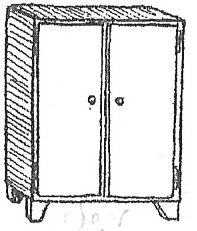Cupboard
Cupboard is a piece of furniture used for storage that is enclosed by doors, and sometimes drawers, typically made of wood, metal, or a combination of materials. Cupboards are used in various rooms of the home, including the kitchen, bathroom, bedroom, and living room, serving the primary function of organizing, storing, and hiding items. The design, size, and functionality of cupboards can vary widely, from simple shelving units to elaborate, multi-functional pieces that include features such as pull-out drawers, spice racks, and integrated lighting.
History[edit | edit source]
The history of the cupboard dates back to the Middle Ages, where it evolved from simple wooden chests and sideboards. Initially, cupboards were a symbol of status, owned by the wealthy and used to store precious items such as silverware and fine china. Over time, the design of cupboards became more sophisticated, with the addition of doors to protect the contents from dust and theft. In the 19th century, with the advent of mass production, cupboards became more accessible to the general public, leading to a variety of designs and styles that catered to different needs and preferences.
Types of Cupboards[edit | edit source]
There are several types of cupboards, each designed for specific storage needs and spaces:
- Kitchen Cupboards: Designed to store food, dishes, and cooking equipment. Modern kitchen cupboards often feature built-in organizers, lazy Susans, and pull-out racks.
- Wardrobe or Armoire: A tall cupboard typically used in bedrooms to store clothes. Wardrobes may come with hanging rods, shelves, and drawers.
- Pantry Cupboards: Used to store food and kitchen supplies. Pantry cupboards can range from small closet-sized spaces to large walk-in rooms.
- Bathroom Cupboards: Designed to hold toiletries, towels, and bathroom supplies. They are often wall-mounted to save space.
- Utility Cupboards: Used in laundry rooms or garages to store cleaning supplies, tools, and other household items.
Materials[edit | edit source]
Cupboards are made from a variety of materials, each offering different aesthetics and durability:
- Wood: The most traditional material, offering warmth and a wide range of finishes. Common woods include oak, maple, cherry, and pine.
- Metal: Used for more industrial or modern designs. Metal cupboards are durable and resistant to pests.
- Laminate: A cost-effective option that can mimic the look of wood or metal. Laminate is easy to clean and maintain.
- Glass: Often used for the doors of cupboards to display contents. Glass can be clear, frosted, or patterned.
Design and Functionality[edit | edit source]
The design of a cupboard can greatly affect its functionality. Features such as adjustable shelves, door mounts, and drawer dividers can help maximize storage space and organization. Lighting inside cupboards, especially in kitchen and display cupboards, enhances visibility and adds an aesthetic element. The style of a cupboard, from traditional to contemporary, can complement or define the decor of a room.
Maintenance[edit | edit source]
Maintaining cupboards involves regular cleaning and, depending on the material, occasional treatment with oils or polishes. It is important to address spills and stains promptly to prevent damage, especially on wood surfaces. Hinges and drawer slides may require lubrication or adjustment to ensure smooth operation.
Conclusion[edit | edit source]
Cupboards are an essential component of home storage and organization. Their evolution from simple storage chests to sophisticated furniture pieces reflects changes in lifestyle, design preferences, and technological advancements. Whether designed for functionality, style, or both, cupboards continue to play a vital role in keeping our living spaces organized and clutter-free.
Search WikiMD
Ad.Tired of being Overweight? Try W8MD's physician weight loss program.
Semaglutide (Ozempic / Wegovy and Tirzepatide (Mounjaro / Zepbound) available.
Advertise on WikiMD
|
WikiMD's Wellness Encyclopedia |
| Let Food Be Thy Medicine Medicine Thy Food - Hippocrates |
Translate this page: - East Asian
中文,
日本,
한국어,
South Asian
हिन्दी,
தமிழ்,
తెలుగు,
Urdu,
ಕನ್ನಡ,
Southeast Asian
Indonesian,
Vietnamese,
Thai,
မြန်မာဘာသာ,
বাংলা
European
español,
Deutsch,
français,
Greek,
português do Brasil,
polski,
română,
русский,
Nederlands,
norsk,
svenska,
suomi,
Italian
Middle Eastern & African
عربى,
Turkish,
Persian,
Hebrew,
Afrikaans,
isiZulu,
Kiswahili,
Other
Bulgarian,
Hungarian,
Czech,
Swedish,
മലയാളം,
मराठी,
ਪੰਜਾਬੀ,
ગુજરાતી,
Portuguese,
Ukrainian
Medical Disclaimer: WikiMD is not a substitute for professional medical advice. The information on WikiMD is provided as an information resource only, may be incorrect, outdated or misleading, and is not to be used or relied on for any diagnostic or treatment purposes. Please consult your health care provider before making any healthcare decisions or for guidance about a specific medical condition. WikiMD expressly disclaims responsibility, and shall have no liability, for any damages, loss, injury, or liability whatsoever suffered as a result of your reliance on the information contained in this site. By visiting this site you agree to the foregoing terms and conditions, which may from time to time be changed or supplemented by WikiMD. If you do not agree to the foregoing terms and conditions, you should not enter or use this site. See full disclaimer.
Credits:Most images are courtesy of Wikimedia commons, and templates, categories Wikipedia, licensed under CC BY SA or similar.
Contributors: Prab R. Tumpati, MD


